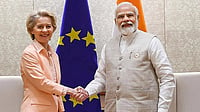NATO-calibre weapons were being transferred to ISIL-K by groups affiliated with the Taliban and Al-Qaeda, such as Tehrik-e Taliban Pakistan, according to a UN report, with member states expressing concern over the proliferation of military equipment within Afghanistan and into neighbouring countries following the 2021 Taliban takeover.
The 17th report of the Secretary-General on the threat posed by ISIL (Da’esh) to international peace and security said that UN member states remained concerned about the proliferation of weapons in Afghanistan, the Middle East and Africa, in particular the access by Da’esh and its regional affiliates to small arms and light weapons, as well as their increased use of unmanned aircraft systems and improvised explosive devices, reported PTI.
“With the Taliban takeover in Afghanistan, member states expressed concern over the proliferation of large quantities of weapons and other military equipment within Afghanistan and into neighbouring states,” the report issued this week said.
Regional Member States reported that “North Atlantic Treaty Organisation-calibre weapons typically associated with the former Afghan National Defence and Security Forces were being transferred to ISIL-K by groups affiliated with the Taliban and Al-Qaeda, such as Tehrik-e Taliban Pakistan (TTP) and the Eastern Turkistan Islamic Movement,” also known as the Turkistan Islamic Party (ETIM/TIP).
In the core conflict zone, Da’esh has reportedly transitioned to producing fewer, simpler and smaller improvised explosive devices and to now using suicide vests only as a last resort, to avoid the loss of operatives.
“There are reports that Da’esh has created a so-called Industry Committee within its structures to explore new avenues for advancement in weaponry, such as improvised explosive devices and increased payloads for drones,” the report said.
The report added that member states assessed ISIL-K as being the most serious terrorist threat in Afghanistan and the wider region.
The group has reportedly increased its operational capabilities inside Afghanistan, with fighters and family members estimated at 4,000 to 6,000 individuals. Sanaullah Ghafari (alias Shahab al-Muhajir) is viewed by some member states as the most ambitious leader of ISIL-K. One Member State reported that Ghafari was killed in Afghanistan in June.
“That remains to be confirmed,” the report said, adding that Mawlawi Rajab is the leader of external operations for ISIL-K.
It said ISIL-K is becoming “more sophisticated" in its attacks against both the Taliban and international targets. The group was reportedly focused on a strategy of carrying out high-profile attacks to undermine the Taliban’s ability to provide security.
“Overall, ISIL-K attacks demonstrated strong operational capability involving reconnoitre, coordination, communication, planning and execution,” the report said, adding that according to some Member States, attacks against high-profile Taliban figures in Balkh, Badakhshan and Baghlan Provinces raised ISIL-K morale and boosted recruitment.
“Some Member States reported that ETIM/TIP had developed links in Afghanistan with ISIL-K, with the two groups jointly publishing propaganda posters and some ETIM/TIP members joining ISIL-K operations. One member state assessed that some elements of Al-Qaeda in the Indian Subcontinent were ready to either join or collaborate with ISIL-K,” the report said.


























